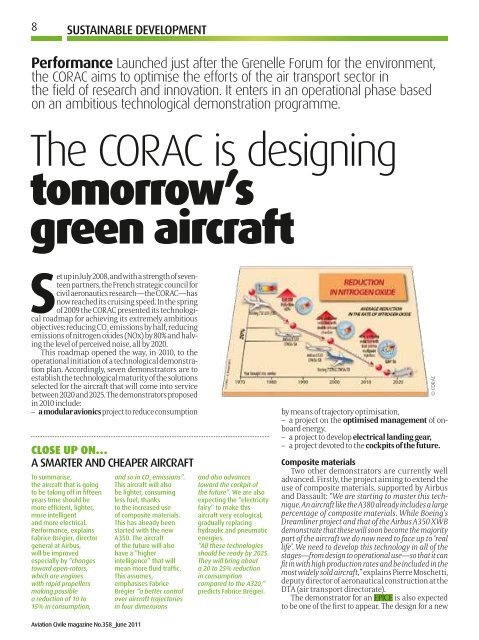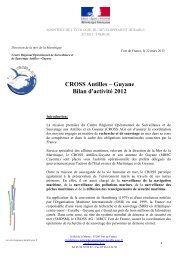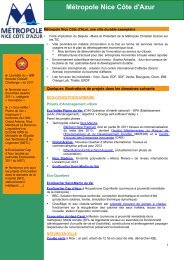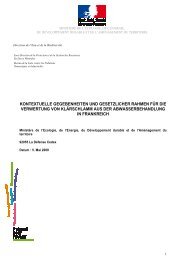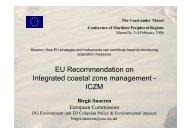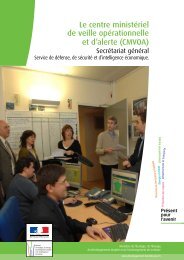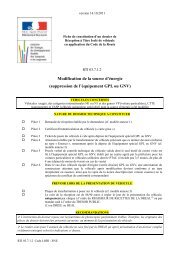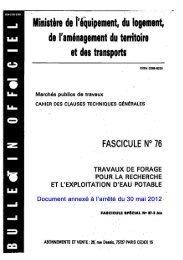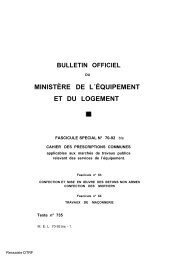Aviation Civile
Aviation Civile
Aviation Civile
Create successful ePaper yourself
Turn your PDF publications into a flip-book with our unique Google optimized e-Paper software.
8 SuSTAINAbLE DEVELoPMENT<br />
9<br />
performance Launched just after the Grenelle Forum for the environment,<br />
the CORAC aims to optimise the efforts of the air transport sector in<br />
the field of research and innovation. It enters in an operational phase based<br />
on an ambitious technological demonstration programme.<br />
The CORAC is designing<br />
tomorrow’s<br />
green aircraft<br />
set up in July 2008, and with a strength of seventeen<br />
partners, the French strategic council for<br />
civil aeronautics research—the CORAC—has<br />
now reached its cruising speed. In the spring<br />
of 2009 the CORAC presented its technological<br />
roadmap for achieving its extremely ambitious<br />
objectives: reducing CO 2 emissions by half, reducing<br />
emissions of nitrogen oxides (NOx) by 80% and halving<br />
the level of perceived noise, all by 2020.<br />
This roadmap opened the way, in 2010, to the<br />
operational initiation of a technological demonstration<br />
plan. Accordingly, seven demonstrators are to<br />
establish the technological maturity of the solutions<br />
selected for the aircraft that will come into service<br />
between 2020 and 2025. The demonstrators proposed<br />
in 2010 include:<br />
– a modular avionics project to reduce consumption by means of trajectory optimisation,<br />
CLoSe uP oN…<br />
A SMARTER AND CHEAPER AIRCRAFT<br />
To summarise,<br />
the aircraft that is going<br />
to be taking off in fifteen<br />
years time should be<br />
more efficient, lighter,<br />
more intelligent<br />
and more electrical.<br />
Performance, explains<br />
Fabrice brégier, director<br />
general at Airbus,<br />
will be improved<br />
especially by ”changes<br />
toward open-rotors,<br />
which are engines<br />
with rapid propellers<br />
making possible<br />
a reduction of 10 to<br />
15% in consumption,<br />
and so in CO 2 emissions”.<br />
This aircraft will also<br />
be lighter, consuming<br />
less fuel, thanks<br />
to the increased use<br />
of composite materials.<br />
This has already been<br />
started with the new<br />
A350. The aircraft<br />
of the future will also<br />
have a “higher<br />
intelligence” that will<br />
mean more fluid traffic.<br />
This assumes,<br />
emphasises Fabrice<br />
brégier “a better control<br />
over aircraft trajectories<br />
in four dimensions<br />
and also advances<br />
toward the cockpit of<br />
the future”. We are also<br />
expecting the “electricity<br />
fairy” to make this<br />
aircraft very ecological,<br />
gradually replacing<br />
hydraulic and pneumatic<br />
energies.<br />
“All these technologies<br />
should be ready by 2025.<br />
They will bring about<br />
a 20 to 25% reduction<br />
in consumption<br />
compared to the A320,”<br />
predicts Fabrice brégier.<br />
– a project on the optimised management of onboard<br />
energy,<br />
– a project to develop electrical landing gear,<br />
– a project devoted to the cockpits of the future.<br />
Composite materials<br />
Two other demonstrators are currently well<br />
advanced. Firstly, the project aiming to extend the<br />
use of composite materials, supported by Airbus<br />
and Dassault: “We are starting to master this technique.<br />
An aircraft like the A380 already includes a large<br />
percentage of composite materials. While Boeing’s<br />
Dreamliner project and that of the Airbus A350 XWB<br />
demonstrate that these will soon become the majority<br />
part of the aircraft we do now need to face up to ‘real<br />
life’. We need to develop this technology in all of the<br />
stages—from design to operational use—so that it can<br />
fit in with high production rates and be included in the<br />
most widely sold aircraft,” explains Pierre Moschetti,<br />
deputy director of aeronautical construction at the<br />
DTA (air transport directorate).<br />
The demonstrator for an EPICE is also expected<br />
to be one of the first to appear. The design for a new<br />
© CORAC<br />
_Vela (Very Efficient Large Aircraft) flying wing. This European project, lead by Airbus,<br />
is also studying the architecture, aerodynamics and mechanics of future aircraft.<br />
engine and a new generation power plant to succeed<br />
the CFM 56 will reduce CO 2 emissions by 15% as well<br />
as cutting noise levels by at least 5 dB by 2016.<br />
In parallel with the demonstrators, several<br />
research directions have been decided, in 2010, in<br />
order to understand better the interactions of air<br />
transport with climate phenomena. “While it is easy<br />
to evaluate the CO 2 emitted by air transport, the question<br />
of how it affects the climate is more complicated.<br />
We are now only at the beginning of research into this<br />
area,” points out Pascal Luciani, deputy director for<br />
Sustainable Development at the DTA.<br />
The work will concentrate on subjects such as new<br />
fuels, condensation trails and ways to detect zones<br />
that are the most likely to generate these trails so that,<br />
ultimately, they can be included in flight control.<br />
To support the financing of these demonstration<br />
platforms over the next five or six years (with<br />
an estimated cost of around 1 billion euros), the<br />
government is going to make available a budget of<br />
500 million euros, from a large bond issue launched<br />
in 2010—an effort commensurate with the ambition<br />
of these projects to create tomorrow’s green aircraft.<br />
henri Cormier<br />
EPICE<br />
Integrated propulsion<br />
unit in composite<br />
materials for<br />
the environment.<br />
QuESTIoNS To…<br />
PIERRE MOSCHETTI,<br />
DePUTY DIReCTOR OF AeRONAUTICAL<br />
CONSTRUCTION AT THe DTA (AIR TRANSPORT<br />
DIReCTORATe)<br />
what is the level of involvement of the dgAC<br />
in the CorAC?<br />
The DGAC has been, along with the GIFAS 1 , an initiator<br />
of the CORAC approach at the ministry for sustainable<br />
development. It has positioned itself as a major player<br />
in its setting up and has taken on the leading role.<br />
Today, this work to organise and structure the actions<br />
has fallen on me, as an aide to the chairman of<br />
the steering committee of the CORAC, Marc Ventre.<br />
do other departments of the dgAC get involved<br />
in CorAC bodies?<br />
As an example, the teams of the DSNA 2 are working<br />
with scientists, aircraft builders, airlines and airports<br />
on key questions such as low-noise approach and<br />
take-off trajectories or interactions between aviation<br />
and atmospheric phenomena.<br />
Representatives of the DSNA are also very active in<br />
maintaining the CORAC roadmap, given their knowledge<br />
of the SESAR 3 project (read p. 10). Finally, the deputy<br />
directorate team for Sustainable Development, lead<br />
by Pascal Luciani, is obviously among the first to be<br />
interested in the work being done by the CORAC.<br />
what does this work need in particular?<br />
A great deal of effort is needed in demonstration and<br />
in focusing on certain sticking points, and this means<br />
coordinating the work of the players in their particular<br />
fields of expertise. But it is just as important to work<br />
at the interfaces between what everyone is doing,<br />
as it is there that the greatest progress can be made.<br />
1/ French aeronautic and space industries group.<br />
2/ Air navigation services directorate.<br />
3/ Single European Sky ATM Research.<br />
<strong>Aviation</strong> <strong>Civile</strong> magazine No.358_ June 2011 <strong>Aviation</strong> <strong>Civile</strong> magazine No.358_ June 2011<br />
© Airbus<br />
© MEEDDM/B. Suard


